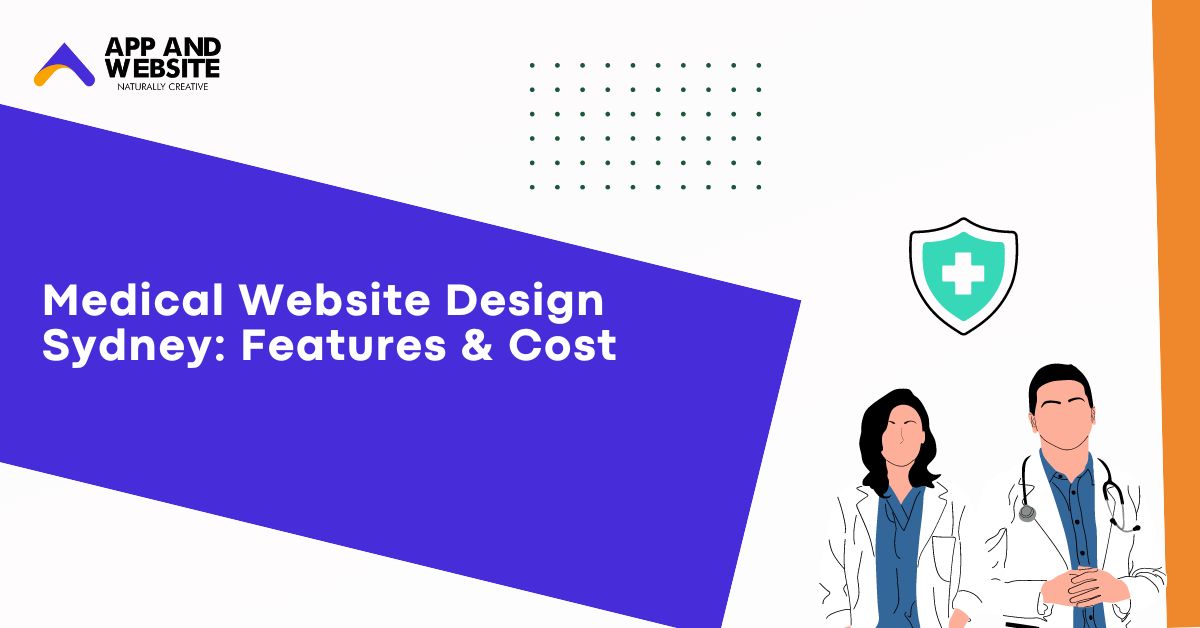Are you a medical professional in Sydney and want to grow your business. Website development is the first steps? It’s time to elevate your online presence and connect with more patients.
A well-designed medical website isn’t just a digital brochure; it’s a powerful tool. It’s your chance to showcase your expertise, build trust, and attract new patients. But with so many options out there, how do you find the right medical website design in Sydney?
That’s where we come in. In this blog, we’ll explore the key elements of a successful medical website and share insights on how to find the perfect design for your practice.
Benefits of Developing a Medical Website
Developing a medical website offers numerous benefits that can enhance the effectiveness and reach of your healthcare practice. Here’s a look at some of the key advantages:
1. Enhanced Patient Accessibility
A well-designed medical website provides patients with easy access to information about your services, location, and contact details. This accessibility helps patients find you quickly and reduces barriers to seeking care.
- 24/7 Availability: Patients can access your website at any time to get information or schedule appointments, even outside of office hours.
- Online Services: Features like appointment booking, prescription refills, and access to medical records offer convenience and improve patient satisfaction.
2. Improved Communication
A medical website facilitates better communication between patients and healthcare providers.
- Appointment Scheduling: An online booking system allows patients to schedule or reschedule appointments effortlessly.
- Patient Portal: A secure patient portal enables direct communication with healthcare providers, access to test results, and management of personal health information.
3. Increased Credibility and Trust
A professional and well-maintained website can significantly enhance the credibility and trustworthiness of your medical practice.
- Professional Image: A modern, user-friendly website reflects a commitment to providing high-quality care and staying current with technology.
- Doctor Profiles: Detailed profiles and credentials of medical staff help build trust with prospective patients by showcasing expertise and experience.
4. Better Patient Engagement
Engaging content and features on your website can keep patients informed and involved in their healthcare.
- Educational Resources: Providing articles, blog posts, and videos on health topics educates patients and establishes your practice as a trusted source of information.
- News and Updates: Regular updates about new services, health tips, and practice news keep patients engaged and informed.
5. Streamlined Operations
A well-developed medical website can streamline various operational aspects of your practice.
- Practice Management Integration: Integrating with your practice management system helps automate administrative tasks such as appointment scheduling and patient record management.
- Efficiency: Reducing the need for phone calls and manual scheduling frees up staff time for other essential tasks.
6. Enhanced Marketing and Visibility
An effective medical website boosts your practice’s online visibility and marketing efforts.
- Search Engine Optimisation (SEO): Optimising your website for search engines improves your practice’s ranking in search results, making it easier for potential patients to find you.
- Online Reputation: Positive patient reviews and testimonials featured on your website enhance your practice’s reputation and attract new patients.
7. Compliance and Security
Developing a medical website with a focus on compliance and security helps protect patient information and adhere to legal standards.
- Data Protection: Implementing secure features such as SSL certificates and encrypted data transmission safeguards patient information.
- Regulatory Compliance: Ensuring your website meets healthcare regulations and accessibility standards avoids legal issues and promotes a safe online environment.
Key Features of a Medical Website Design Sydney
A well-designed medical website should include several key features to ensure it meets the needs of both patients and healthcare providers. Here’s a breakdown of essential features that contribute to a functional and effective medical website:
1. Appointment Booking System
- Online Scheduling: Allows patients to book, reschedule, or cancel appointments online. This feature should be user-friendly and accessible.
- Real-Time Availability: Displays available time slots in real-time to avoid scheduling conflicts.
- Automated Reminders: Sends appointment reminders via email or SMS to reduce no-shows.
2. Telehealth Integration
- Virtual Consultations: Provides the capability for video consultations, enabling remote consultations between patients and healthcare providers.
- Secure Communication: Ensures that telehealth interactions are secure and compliant with privacy regulations.
3. Patient Portal
- Access to Records: Allows patients to view their medical records, test results, and treatment history securely.
- Direct Messaging: Facilitates direct communication between patients and their healthcare providers for questions or follow-ups.
- Personal Health Management: Enables patients to manage their health information, such as medication lists and appointment history.
4. Service Pages
- Detailed Descriptions: Provides comprehensive information about the medical services offered, including treatments, procedures, and specialties.
- FAQs: Addresses common questions related to services, procedures, and office policies.
5. Doctor Profiles
- Biographical Information: Includes details about the medical staff’s qualifications, specialties, and professional experience.
- Patient Reviews: Features patient reviews and testimonials to build trust and credibility.
6. Mobile Responsiveness
- Optimised Design: Ensures that the website is fully functional and visually appealing on all devices, including smartphones and tablets.
- User-Friendly Navigation: Guarantees that navigation is seamless and intuitive, regardless of the device used.
7. Search Engine Optimisation (SEO)
- Keyword Integration: Utilises relevant keywords to improve search engine rankings and attract more visitors.
- Local SEO: Optimises the website for local searches to ensure it appears in search results for users in your geographical area.
8. Content Management System (CMS)
- Ease of Updates: Allows for easy updating of content, such as news, blog posts, and service information.
- User-Friendly Interface: Provides a straightforward interface for managing and publishing content without requiring advanced technical skills.
9. Security Features
- SSL Certificates: Ensures that all data transmitted between the user and the website is encrypted and secure.
- Data Protection: Implements measures to protect sensitive patient information and comply with privacy regulations.
10. Contact Information and Forms
- Easy Access: Provides clear and accessible contact information, including phone numbers, email addresses, and office locations.
- Contact Forms: Includes forms for general inquiries, feedback, or appointment requests to facilitate communication with the practice.
11. Accessibility Features
- Compliance with WCAG: Ensures the website meets Web Content Accessibility Guidelines to be usable by individuals with disabilities.
- Readable Fonts and Colors: Utilises high-contrast colors and readable fonts to enhance accessibility.
By incorporating these key features, a medical website can effectively serve its audience, improve patient experience, and streamline practice operations.
Steps to Develop a Medical Website
Developing a medical website involves several key steps to ensure it is functional, compliant, and user-friendly. Here’s a step-by-step guide to help you through the process:
1. Define Your Objectives
- Identify Goals: Determine what you want to achieve with your website, such as improving patient engagement, streamlining appointment scheduling, or providing telehealth services.
- Gather Requirements: Outline the features and functionalities you need, such as appointment booking, patient portals, and telehealth integration.
2. Research and Planning
- Market Research: Analyse competitors and similar medical websites to understand industry standards and identify best practices.
- Audience Analysis: Define your target audience and their needs to ensure the website meets their expectations and preferences.
- Regulatory Compliance: Familiarise yourself with healthcare regulations and data protection laws applicable in your region, such as the Australian Privacy Principles (APPs).
3. Choose a Domain Name and Hosting
- Domain Name: Select a relevant, easy-to-remember domain name that reflects your practice’s name and services.
- Hosting Provider: Choose a reliable hosting provider that offers good performance, security, and support.
4. Design and Development
- Wireframes and Mockups: Create wireframes and design mockups to visualise the website layout and structure.
- User Experience (UX) Design: Focus on creating a user-friendly design that ensures easy navigation and accessibility.
- User Interface (UI) Design: Develop an appealing visual design that aligns with your brand and professional image.
5. Develop Key Features
- Appointment Booking System: Implement an online scheduling system with real-time availability and automated reminders.
- Telehealth Integration: Set up secure video consultation capabilities if offering telehealth services.
- Patient Portal: Develop a secure portal for patients to access their medical records, communicate with healthcare providers, and manage their health information.
6. Content Creation
- Content Strategy: Develop a content strategy that includes informative and engaging content related to your services, health tips, and practice updates.
- SEO Optimisation: Optimise content with relevant keywords and ensure it is structured to improve search engine rankings.
7. Testing and Quality Assurance
- Functionality Testing: Test all website features, including appointment scheduling, patient portals, and contact forms, to ensure they work correctly.
- Cross-Browser and Device Testing: Verify that the website functions properly across different browsers and devices, including mobile phones and tablets.
- Accessibility Testing: Ensure the website meets accessibility standards to accommodate users with disabilities.
8. Launch the Website
- Final Review: Conduct a final review to ensure all content, features, and functionalities are in place and working as expected.
- Go Live: Publish the website and monitor its performance to address any issues that may arise.
9. Ongoing Maintenance and Updates
- Regular Updates: Continuously update the website with new content, features, and security patches to keep it current and secure.
- Performance Monitoring: Monitor website performance and user feedback to identify areas for improvement and ensure optimal functionality.
- Backup and Security: Implement regular backups and maintain robust security measures to protect against data loss and cyber threats.
10. Evaluate and Improve
- Analytics: Use web analytics tools to track visitor behavior, site performance, and user engagement.
- Feedback: Collect feedback from patients and staff to identify any issues or areas for enhancement.
- Iterate: Make improvements based on feedback and analytics to continually refine and optimise the website.
Cost to Develop a Medical Website in Sydney
The cost of developing a medical website in Sydney can vary widely based on several factors, including the complexity of the site, the features required, and the level of customisation. Here’s a breakdown of the key cost components to consider:
1. Initial Setup Costs
- Domain Name: Typically ranges from AUD 10 to AUD 50 per year, depending on the domain extension and registrar.
- Web Hosting: Costs can range from AUD 100 to AUD 500 per year, depending on the type of hosting (shared, VPS, or dedicated) and the provider’s features.
2. Design and Development Costs
- Custom Design: A custom-designed website can cost between AUD 3,000 and AUD 10,000. This includes bespoke design elements and tailored user experience (UX) and user interface (UI) design.
- Template-Based Design: Using pre-designed templates can reduce costs, ranging from AUD 1,500 to AUD 4,000, but may offer less customisation.
3. Key Features Integration
- Appointment Booking System: Integration costs for a booking system can range from AUD 1,000 to AUD 3,000, depending on the complexity and integration with existing practice management systems.
- Telehealth Integration: Adding telehealth functionality can cost between AUD 2,000 and AUD 5,000, depending on the level of integration and security features.
- Patient Portal: Developing a secure patient portal typically costs between AUD 3,000 and AUD 6,000, depending on the features and level of security required.
4. Content Creation
- Copywriting: Professional copywriting for website content can range from AUD 500 to AUD 2,000, depending on the volume and complexity of the content.
- Photography and Graphics: Custom images and graphics can cost between AUD 500 and AUD 2,000, depending on whether you use stock images or hire a photographer.
5. SEO and Digital Marketing
- SEO Services: Initial SEO setup and optimisation can range from AUD 1,000 to AUD 3,000, with ongoing monthly services costing between AUD 500 and AUD 1,500.
- Digital Marketing: Costs for digital marketing efforts, such as pay-per-click advertising and social media promotion, vary based on the scope and can range from AUD 500 to AUD 2,000 per month.
6. Ongoing Maintenance and Support
- Website Maintenance: Regular updates, security patches, and backups typically cost between AUD 500 and AUD 1,500 per year, depending on the level of service and frequency of updates.
- Technical Support: Support services may cost between AUD 100 and AUD 300 per hour if needed.
7. Compliance and Security
- SSL Certificate: Essential for securing data and compliance, SSL certificates cost between AUD 100 and AUD 500 per year, depending on the level of security required.
- Data Protection: Ensuring compliance with privacy regulations may involve additional costs for security audits and measures, ranging from AUD 500 to AUD 2,000.
Summary of Estimated Costs
- Basic Website (Template-Based): AUD 2,500 – AUD 6,000
- Custom Website: AUD 5,000 – AUD 15,000
- Additional Features (Booking System, Telehealth, Portal): AUD 4,000 – AUD 12,000
- Ongoing Maintenance and Support: AUD 500 – AUD 1,500 per year
- SEO and Marketing: AUD 1,500 – AUD 5,000 (initial setup), AUD 500 – AUD 2,000 per month for ongoing services
These estimates provide a general idea of the costs involved in developing a medical website in Sydney. The final cost will depend on your specific requirements, the complexity of the project, and the service providers you choose.
Why Choose App and Website For Medical Web Design Sydney
Choosing App and Website for your medical web design Sydney ensures a seamless blend of professional expertise and tailored solutions. We specialise in creating custom, user-friendly websites that meet the specific needs of healthcare providers, integrating essential features like appointment scheduling, telehealth services, and secure patient portals. Our commitment to compliance with healthcare regulations and focus on delivering a visually appealing and functional design sets us apart. With a dedicated team of experienced designers and developers, we deliver high-quality, accessible websites that enhance patient engagement and streamline practice operations.
Conclusion
In conclusion, medical website design Sydney involves careful planning, investment in key features, and a focus on compliance and user experience. By understanding the costs and benefits, and choosing a provider who offers customised, secure, and user-friendly solutions, you can create a powerful online presence that enhances patient care and supports your practice’s growth. Invest in a website that not only meets regulatory standards but also engages and serves your patients effectively.







